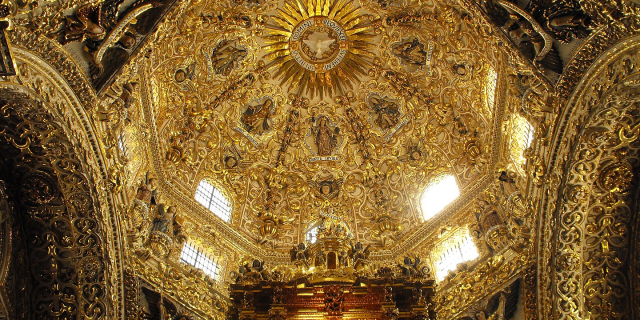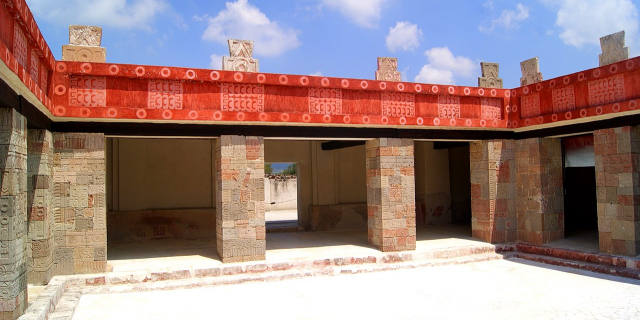The Basilica Cathedral of Puebla, as the Cathedral of Our Lady of the Immaculate Conception is known according to its Marian invocation, is the episcopal see of the Archdiocese of Puebla de los Ángeles (Mexico). It is one of the most important buildings in the historic center of Puebla declared a World Heritage Site by UNESCO. It has the prerogative of being the first sumptuous temple that under fine architectural designs was built in the Americas, consecrated in 1649, ahead of the Metropolitan of Mexico that was dedicated in 1653. It was founded by Philip II of Spain.
The current Herrerian-style cathedral was built between the 16th and 17th centuries, and replaced the previous one that existed in what is now the atrium. Seventy-four years passed from the beginning of its construction in 1575 to its consecration, during the reigns of three successive kings of Spain, Philip II, Philip III and Philip IV. The setbacks that occurred throughout those years led to numerous mo...Read more
The Basilica Cathedral of Puebla, as the Cathedral of Our Lady of the Immaculate Conception is known according to its Marian invocation, is the episcopal see of the Archdiocese of Puebla de los Ángeles (Mexico). It is one of the most important buildings in the historic center of Puebla declared a World Heritage Site by UNESCO. It has the prerogative of being the first sumptuous temple that under fine architectural designs was built in the Americas, consecrated in 1649, ahead of the Metropolitan of Mexico that was dedicated in 1653. It was founded by Philip II of Spain.
The current Herrerian-style cathedral was built between the 16th and 17th centuries, and replaced the previous one that existed in what is now the atrium. Seventy-four years passed from the beginning of its construction in 1575 to its consecration, during the reigns of three successive kings of Spain, Philip II, Philip III and Philip IV. The setbacks that occurred throughout those years led to numerous modifications of the original layout. By 1624 the works were completely suspended until the arrival of Bishop Juan de Palafox y Mendoza in July 1640, who resumed the works with determined enthusiasm. The new reforms gave a higher elevation to the central nave above the processional ones, allowing the passage of natural light and giving it the appearance of a pyramidal structure. It was consecrated by Bishop Juan de Palafox y Mendoza on April 18, 1649, without having been completely finished.
The space it occupies is rectangular in shape, recharged in the corner of another larger floor, forming a large space for the atrium. The building is organized into five naves: a central one, two lateral ones and two niche chapels, its Renaissance-style façade stands out. Attached to its back is a building for offices of the Mitra, its former headquarters, and the building of the chapel called Ochavo. With its little more than 70 meters high, it was the tallest church in the Spanish colonies.
The cathedral is considered one of the most important museums of New Spanish and later art due to the treasures it houses. Over the centuries it has been enriched in works of painting, sculpture, goldsmithing and carpentry of great artistic quality, as well as its decorations, the large boarded doors, aluminum and the treasures of the sacristy that protect the rich priestly ornaments embroidered with gold and silver thread, sacred vessels, chalices, ciboria, reliquaries and crosses bathed in gold inlaid with jewels and diamonds. Its historical archive has documents dating back to the founding of the city and many are waiting to be classified.

On January 24, 1557 Viceroy Martín Enríquez (1562–80) authorized construction. The design was submitted to the Dean and Cathedral Chapter on November 11, 1557.[1] Construction began in November 1575, under the direction of architects Francisco Becerra and Juan de Cigorondo. Construction was interrupted in 1626 but in 1634 Juan Gómez de Trasmonte modified the design and construction began again in 1640 when Bishop Juan de Palafox y Mendoza arrived with the appointment of visitor-general of New Spain and bishop of Puebla. The cathedral was in bad shape, the building not yet completed and unconsecrated. When Palafox lost his struggle with the Jesuits and viceroy Salvatierra, he was appointed bishop to a minor diocese in Spain, but before he left New Spain in 1649 he devoted considerable energy to completing the cathedral and its consecration. The renovation over nine years had cost 350,000 pesos, engaged 1,500 workers under the supervision of an Aragonese Pedro García Ferrer. The ceremony of consecration performed on April 18, 1649, and for Palafox was not only the culmination of the massive building project but also his grand farewell to his diocese.[2] The Cathedral was consecrated to the Virgin Mary in a huge and emotional ceremony, with civil and religious participants, the reburial of the remains of previous prelates, brilliant musical performances, and a sermon by Palafox himself in his final farewell to his flock.[3] It was not entirely completed until 1690. The front façade was built out of black limestone, and it has two towers, the tallest in Mexico,[4] one of which has no bells. According to legend, an underground river passes under that tower and if bells were placed in it, the tower would collapse.






























Add new comment